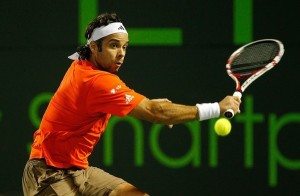By Thomas Swick
Every spring they come, out of the desert to this subtropical isle, where the temptations are infinitely greater. The beach is a high-arcing lob away. Restaurants and bars sit just across the causeway. Coconut Gove is to the south; the American Airlines Arena to the north. South Beach, with its clubs and models, can be reached in minutes in a cigarette boat. (You don’t get cocaine-contaminated French kissing in Indian Wells.) To win in Key Biscayne requires not just talent and drive but also a kind of puritanism.
True, professional tennis players are world-weary travelers, somewhat immune to the culture shock that grips the rest of us. For many of them, Miami is just another luxury hotel and a white-bordered rectangle, this week painted purple. They may not be puritans but, during a tournament at least, they’re like ascetics, eschewing life’s pleasures to concentrate on diet, sleep, fitness, drills. H.L. Mencken famously described puritanism as “the haunting fear that someone, somewhere, is having a good time.” The players who rise to the top in tennis have the haunting fear that someone, somewhere, is having a harder workout. Which makes them train even longer. Doing it under palm trees doesn’t make it any easier.
But when the matches begin, players are reminded where they are. Thanks to the nature of the local population, the fans at the Sony Ericsson are a passionate group. In 1998, when Marcelo Rios reigned as the world’s #1, a small contingent wandered the grounds with a Chilean flag, looking like a band of sneakered revolutionaries.
I once sat at a match between Sandrine Testud, a Frenchwoman, and Fabiola Zuluaga, a Colombian with one of the great names in the history of tennis. (She should be in the Hall of Names next to Evonne Goolagong.) The crowd appeared to be 98% Colombian, and they made the match, which stretched into the evening, sound like a Grand Slam final. One man sitting in the front row at the net turned to Testud before every serve and demonstrably put a hex on her.
I have never actually seen voodoo or Santaria practiced at the Sony Ericsson Open, though who knows what happens at night in Little Haiti and Little Havana? (Some nighttime excursions for the underdogs to consider.) But once, during a changeover in a match between Jonas Bjorkman and Leander Paes, a large iguana scurried across the court.
A few years ago a frustrated Francesca Schiavone, playing doubles against two Latinas, turned and addressed the fans after being cheered for an unforced error. In her endearing way, the small Italian said she understood that they were rooting for her opponents, but beseeched them not to ridicule her in the process.
It was an example of how the emotionalism in the stands can sometimes trickle onto the court. This is one of the few tournaments at which Roger Federer has smashed a racket, and it was here that an enraged Mikhail Youzhny suffered self-inflicted racket wounds to the head.
Wednesday passion was in short supply, which can be expected at the start of a tournament. Michael Llodra bowed out without insulting any fans, and Venus Williams won easily in a rather subdued stadium. Christina from Ithaca, NY – a presence at tournaments around the world, often in a Federer shirt – was dressed in unaffiliated attire. (She had just come from watching her hero practice.)
The Urszula Radwanska-Kateryna Bondarenko match produced some histrionics, as both players engaged in frequent self-castigation. After Radwanska lost in the third set, the man next to me said to his friend: “I told you she was going to lose. She swears too much.”

The night match in the stadium – between Nicolas Mahut and Fernando Gonzalez – brought out Chileans hoping they would not witness their countryman’s final match. (Gonzalez had announced that the Sony Ericsson would be his last tournament.) It was a gentler crowd than the one that had watched the Testud-Zuluaga match; a few people held up Chilean flags and seven men sat in bright red shirts, each printed with a big white letter so that as a group they spelled G-R-A-C-I-A-S. During the third set tiebreak, all the photographers pointed their cameras at Gonzalez. After he lost it – on a career-ending double fault – he got a hug from Mahut, a standing ovation from the crowd, and – in an on-court ceremony – a plaque commemorating his passionate career.
